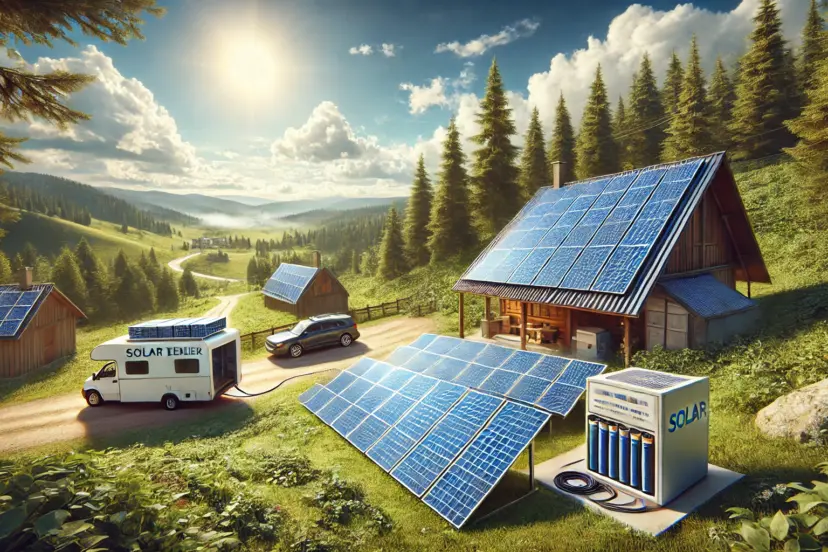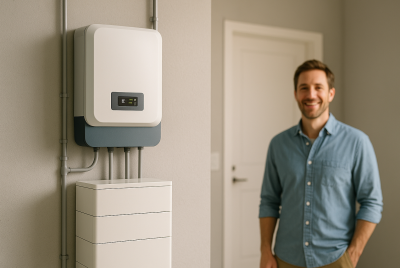Charging Batteries with Solar Power: A Practical Guide
Let’s discuss a fascinating and revolutionary idea: charging batteries with solar power. Imagine powering your devices, your house, or even your camper van with the sun—that enormous ball of fire in the sky. It’s not merely a dream of the future; it’s already happening now. Once installed, solar energy is dependable, clean, and, best of all, cost-free. You’ve arrived at the ideal location if you’re prepared to explore the world of solar charging.
What Is Solar Battery Charging?
What is the situation with solar battery charging, then? In essence, it involves absorbing solar radiation, converting it into electrical energy, and storing that energy in a battery for later use. Imagine it like stifling the sun on overcast days. You can use this energy anywhere and at any time with the correct system. Solar battery charging enables you to do anything, from charging your phone in the middle of nowhere to lighting up a room.
Why Solar Power Is a Smart Choice
Making the switch to solar electricity is not only fashionable, but also wise. First of all, you’re helping to save the environment because it’s very eco-friendly. Secondly, it ultimately saves you money because—guess what? There is no utility cost associated with sunshine. Additionally, you are not vulnerable to increases in electricity prices or power disruptions. Solar power provides the ultimate flexibility, whether you’re off the grid or simply want a dependable backup.
Understanding How Solar Panels and Batteries Work Together
To put it simply, this is how it operates. Sunlight is captured by solar panels and converted into electrical power. Direct current (DC), the unprocessed version of this electricity, can be too much for batteries to handle directly. Enter the charge controller, which ensures that the battery only receives what it can manage, much like a bouncer at a club. This energy is then stored in the battery so that it can be used whenever needed. Easy, isn’t it?
Types of Batteries Used for Solar Charging
Not all batteries are created equal, especially when it comes to solar power. Lead-acid batteries are the old-school option—cheap and dependable but a bit high-maintenance. Lithium-ion batteries are the rock stars of the solar world: lightweight, efficient, and long-lasting. Nickel-cadmium batteries have serious staying power but aren’t as popular due to environmental concerns. There are also flow batteries, which are pretty niche but great for large-scale setups. Choose the one that fits your vibe (and budget).
Setting Up a Solar Battery Charging System
Getting your solar setup going might sound complicated, but it’s not rocket science. You start by picking solar panels that match your energy needs and pair them with a battery that has enough juice to store it all. The charge controller is your system’s unsung hero, regulating energy flow and keeping things safe. Once you’ve hooked everything up, keep an eye on it to make sure it’s running smoothly. And boom—you’re in the solar game.
Common Uses for Solar Battery Charging
Solar charging isn’t just for tech geeks or eco-warriors. It’s practical for all sorts of things. Got a power outage? Your solar battery’s got your back. Love camping? Solar panels can keep your gear running in the middle of nowhere. Boating enthusiasts swear by solar systems to stay powered on the water. And in emergencies—think hurricanes or snowstorms—a solar-charged battery can be a lifesaver. It’s not just handy; it’s essential.
Overcoming Challenges in Solar Battery Charging
Every rose has its thorns, and solar charging is no different. Cloudy days can mess with your vibe by reducing efficiency, but you can work around this with bigger batteries or hybrid setups. The upfront cost might feel like a lot, but think of it as an investment that’ll pay off big time. And yes, you’ll need space for your panels, but even that’s manageable with a bit of planning. Challenges? Sure. Deal-breakers? Not at all.
The Future of Solar Battery Technology
If you think solar power is cool now, just wait. The future is looking insanely bright (pun intended). Researchers are working on next-level batteries that last longer and store more energy. Imagine windows that double as solar panels or bendy solar cells that can wrap around almost anything. The possibilities are endless, and they’re not decades away—they’re right around the corner. Solar power is only going to get better and more accessible.
Maintaining Your Solar Battery System
Think of your solar setup like a car—it needs a bit of TLC to keep running smoothly. Clean your panels regularly because dirt and grime can block sunlight. Check your connections every now and then to make sure everything’s tight and corrosion-free. If you’re not using the batteries for a while, store them in a cool, dry spot. A little maintenance goes a long way in keeping your system in top shape.
Innovations in Solar Battery Charging: Research Highlights
Recent advancements in solar battery charging have pushed the boundaries of energy storage and efficiency. Researchers at the Daegu Gyeongbuk Institute of Science and Technology have developed self-charging supercapacitors that integrate a solar cell with a supercapacitor. This system achieves an impressive 63% energy storage efficiency, paving the way for more efficient solar energy solutions. Another comprehensive review published in Sustainability explores the integration of solar photovoltaic systems with electric vehicle charging stations. This review covers market trends, technical requirements, and future challenges, providing a deep dive into the possibilities of solar-powered EV infrastructure. These studies underscore the potential of solar technology in revolutionizing energy storage and usage.
Top Solar Battery Charging Products on Amazon
If you’re ready to dive into solar power, there are some fantastic products available on Amazon to get you started. These items combine practicality with cutting-edge technology, making solar battery charging accessible and efficient.
The Jackery Explorer 1000 is a powerhouse for off-grid energy needs. With its ability to store energy from solar panels and charge devices like phones, laptops, and even small appliances, it’s perfect for camping, emergencies, or backup at home. Its compatibility with Jackery SolarSaga panels ensures a seamless solar charging experience.
Renogy’s 100W solar panel kit is a popular choice for beginners and pros alike. This kit includes a high-efficiency solar panel, charge controller, and essential cables, making it an all-in-one solution for charging batteries. Whether you’re setting up a home solar system or powering your RV, this kit delivers reliable performance.
Goal Zero’s Yeti 500X is a versatile and compact power station designed for solar integration. It pairs seamlessly with Goal Zero solar panels and is capable of powering everything from smartphones to small fridges. It’s an ideal choice for those looking to transition to solar power without a full system setup.
For a more robust setup, the ECO-WORTHY 200W solar kit is a great pick. It includes two 100W solar panels, a 20Ah lithium battery, and a charge controller. This kit is ideal for cabins, RVs, and backup systems, offering dependable energy storage and output.
Compact and efficient, the BigBlue 3 28W Solar Charger is designed for charging small devices like smartphones, tablets, and cameras. It features multiple USB ports and a foldable design, making it a great choice for travel and outdoor activities.
FAQs
1. Can I charge any type of battery with solar power?
No, not all batteries are up for the task. It’s best to stick with batteries designed for solar systems, like lithium-ion or lead-acid options.
2. How long does it take to charge a battery with solar power?
It depends on the battery size, the power of your solar panels, and how much sunlight you’re getting. Larger batteries or cloudy days mean longer charging times.
3. Do solar panels work in winter?
Absolutely! As long as there’s sunlight, your panels will work. They might be a bit less efficient due to shorter days or snow cover, but they’re still effective.
4. Is it safe to charge batteries with solar power?
Yes, as long as you’re using the right equipment and a charge controller to manage the energy flow. It’s safe and efficient when done right.
5. How long do solar batteries last?
Solar batteries typically last anywhere from 5 to 15 years. Regular maintenance and proper care can help them last even longer.




